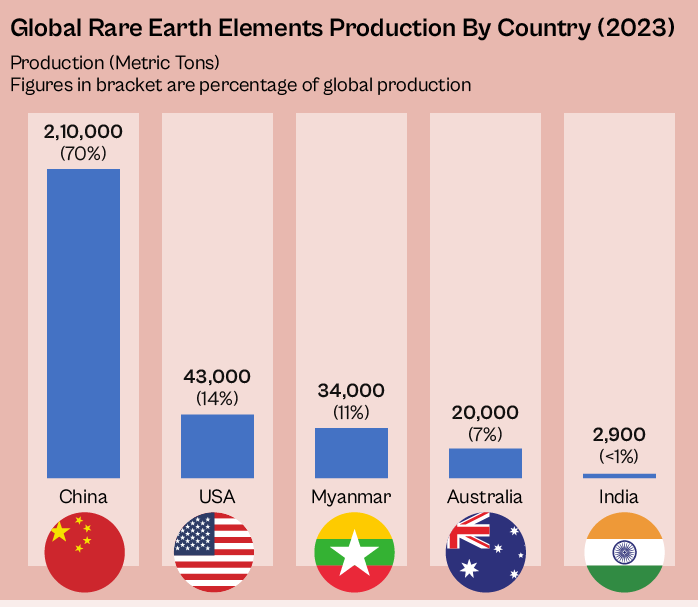Context:
The U.S. President Donald Trump and his Chinese counterpart XiJinping recently concluded a summit in South Korea with a deal to keep Chinese rare earth exports flowing.
What Are Rare Earth Elements?
Rare earths refer to a group of 17 metallic elements in the periodic table — comprising 15 lanthanides along with scandium and yttrium. These metals are silvery-white, soft, and highly reactive.
· Although not geologically “rare,” they are dispersed in low concentrations across the Earth’s crust, making extraction and separation both complex and costly.
List of Rare Earth Elements:
Scandium, Yttrium, Lanthanum, Cerium, Praseodymium, Neodymium, Promethium, Samarium, Europium, Gadolinium, Terbium, Dysprosium, Holmium, Erbium, Thulium, Ytterbium, and Lutetium.
Applications:
Rare earths are vital due to their unique magnetic, luminescent, and electrochemical properties, which make them irreplaceable in several cutting-edge technologies:
1. Electronics: Found in smartphones, laptops, and television screens.
2. Renewable Energy: Neodymium and dysprosium are essential for high-performance permanent magnets used in wind turbines and electric vehicle (EV) motors.
3. Defence and Aerospace: Critical for fighter jets (like the F-35), missiles, radar systems, and satellite communication.
4. Medical and Industrial Uses: Utilized in MRI machines, oil refining, and catalysts for emission control.
Even though these elements are required in minute quantities, their absence can halt entire supply chains, as seen when Chinese export restrictions recently caused disruptions in global manufacturing.
Global Production and China’s Dominance:
Historically, the U.S. pioneered REE processing technologies in the 1950s. However, from the 1980s onwards, China has come to dominate the sector due to:
-
- Low production costs
- Lax environmental regulations
- Strong government support
- Low production costs
Today, China accounts for ~60% of global mine production and over 90% of refining and magnet output.
India and Rare Earths:
India owns significant reserves, mainly in monazite sands found along the Kerala–Tamil Nadu coast.
· Organisations like Indian Rare Earths Limited (IREL) and Bhabha Atomic Research Centre (BARC) are involved in mining and processing.
· However, challenges such as limited refining capacity and regulatory hurdles hinder India’s emergence as a major player.
Conclusion:
Rare earth elements are the lifeblood of the 21st-century digital and green economy. Their strategic and economic value makes them both a technological enabler and a geopolitical vulnerability. As the world transitions to clean energy and advanced electronics, ensuring sustainable and diversified supply chains—while addressing environmental impacts—will be critical for future global stability and technological progress.







